Continuous Performance Management: A Complete Guide to Understanding and Implementing the System

Sorry, there were no results found for “”
Sorry, there were no results found for “”
Sorry, there were no results found for “”
It’s that time of the year again. You can smell fear in the air… No, it’s not Halloween, but rather something much scarier. It’s annual performance reviews. 😅
While the intentions behind yearly appraisals are valid, let’s face it—almost everyone dreads them. HR managers shudder at the thought of all the paperwork, whereas employees brood over every mishap that could rid them of their chance to get promoted. You can’t help but wonder whether there’s a better way to approach performance assessment.
The good news is that there is. It’s called continuous performance management—a method that has revolutionized many companies’ HR operations. In this article, we’ll tell you all about this system, its pros and cons, and the steps you can take to implement it.
Continuous performance management implies regular and less formal reviews throughout the year instead of strict annual appraisals.
Continuous performance management, also known as agile performance management, was created in response to the developments in the business landscape. Changes occur constantly, so modern businesses must be fast-paced and flexible to remain successful. They can’t afford to manage employees’ performance only once a year. They must create an ongoing process in which they invest in their employees and empower them to improve continuously. 💪
Many companies, including giants such as Adobe, Inc. and IBM, have adopted continuous performance management systems. Even General Electric, a company that popularized the annual performance review process, moved on to more frequent and informal performance assessments.
Pro tip: ClickUp, a powerful project management tool, provides all the means you need to implement and maintain an effective performance management system. Leverage it to organize work, communicate across departments, and track progress.
The process of implementing continuous performance management consists of three crucial steps:
We’ll tell you more about each in the next sections.
The first step in continuous performance management is goal-setting. It should start before the employee is even hired. You should define your expectations in the job description. Candidates must understand how their job and performance align with broader organizational goals.
Once the employee is hired, you should collaboratively set goals and key performance indicators specific to their work. These will provide a framework for evaluating the employee’s performance. By making the goals transparent and involving the employee in the process, you’ll prevent misinterpretation and ensure accountability.
You must complete the goal-setting process by defining the timeline. Smaller deliverables and shorter deadlines are preferred because they make goals seem more achievable. When the employee completes a short-term goal, they get the satisfaction of checking it off their to-do list, while you get to see tangible results. It’s a win-win situation! 🏆
You should revisit goals and key performance indicators to accommodate changing business objectives and the employee’s real-life progress.
Pro tip: Set Goals in ClickUp and define trackable Targets to measure the employee’s progress. You can manage all employee performance goals using simple folders.

The continuous performance management model entails conducting check-ins every one to three months. These can be one-on-one sessions with the employee, allowing you to discuss progress toward the preset goals. 🗣️
Check-ins are informal, two-sided performance discussions. Besides real-time feedback and recognition, they offer the employee an opportunity to voice their concerns about their own performance. The manager can then coach them on how to overcome the hurdles and continue improving. This approach allows you to nip potential problems in the bud and prevent them from hindering progress further.
Pro tip: Take advantage of the ClickUp Employee & Manager 1-on-1 Template to prepare the agenda for your check-ins and take notes.

Reviews are more formal assessments of the employee’s performance and progress toward goals. They deal with the technical aspects, such as training, compensation, and promotions. Since the manager and the employee communicated openly during check-ins, the performance review mostly serves as a more formal recap of the final assessment.
At the end of the review cycle, you should form conclusions, document the employee’s performance, and praise their achievements. If they’ve met their goals, you should define new ones, starting a new performance management cycle. 🔁
Pro tip: ClickUp has several templates to help shape your performance reviews! For instance, you can document all the key information about the employees’ performance and resulting decisions with the ClickUp Performance Review Template.

If you do it right, continuous performance management can transform your company for the better. Some of its most impactful benefits include:
When you set goals alongside employees, there’s a lower chance of misunderstandings. In case any do happen, you can resolve them quickly during one of your regular check-ins.
As time goes on, goals will have to shift. Frequent reassessment of goals allows you to target what’s most important at the moment. Goals that are well-defined, current, and relevant are more likely to be achieved. ✅
By evaluating performance annually, you have to deal with a slew of employee data at once. Plus, a lot can change in a year, so a good portion of the data may not be relevant by the time of assessment. 🙅
Continuous performance management encourages more frequent evaluation. This approach allows you to focus only on key data and get real-time insights into employees’ performance. With employee input, you can identify any external factors that may have been at play and round off your understanding of their performance.
When you encourage employees to participate in goal-setting and give continuous feedback, they feel seen and heard. They’re more invested in accomplishing said goals. Such a mutually trusting relationship increases job satisfaction and loyalty to the company.
Continuous performance management contributes to many positive outcomes as it:
It’s not just in theory—there are numbers to back it up. Only a few years after implementing its Check-In system, Adobe saw a 30% decrease in employee resignations and a 50% decrease in involuntary departures.
Continuous performance management shifts the focus from evaluation to learning. While you must assess performance, the aim isn’t to instill fear about its consequences but rather to encourage employee development. 🌱
That’s why employees have to play an active part in the performance review process. You must give and receive regular feedback.
Clear goals, ongoing feedback and support, and employee motivation can improve performance of individual employees as well as the entire team and organization. An increase in performance also leads to better financial and business outcomes.
Although it requires a significant investment at first, continuous performance management saves time and money in the long run. 💸
Let’s go back to our Adobe example. With the old system, its managers were spending over 80,000 hours on annual reviews, which sparked the change. The company was able to make up for most of this time by implementing the new performance evaluation process. This is one of the reasons why Adobe prevails as one of the most profitable tech companies today.
Bonus read: Check out the best performance management tools for 2024!
While effective and profitable in the long haul, continuous performance management is not some magic formula. It comes with a list of distinct concerns and downsides. Read about the most prominent ones below.
Continuous performance management requires you to rethink and redesign many of your HR processes. It requires a significant up-front investment, both time and money-wise. To make it happen, you need to get everyone on board—from upper management to employees. It’s also not a one-size-fits-all solution. You need to find a way to adapt it to your specific case.
Once you get approval, appropriate training is a must to ensure consistency. If inconsistent, the new system will lose its meaning and bring more harm than good. Considering the amount of work needed, ongoing communication and organization are necessary to hold the system together. Otherwise, there’s a risk regular work will suffer as a result.
Even if you implement continuous performance management, there’s no guarantee it will work for you. You must revise your system based on trial and error. That may not be easy to do considering how long it takes to observe tangible results.
If conducted haphazardly, regular performance assessments will put a strain on managers and employees alike. Employees may feel constantly under scrutiny, which will achieve the opposite effect than intended and damage their self-esteem. Managers will also need sufficient support as they have crucial roles in this process and will likely feel under pressure. 😵
More regular performance reviews also mean more data. Unless you have a solid data management system, continuous performance management will overwhelm your managers with administrative work. Because of that, they may struggle to derive significant insights from the data or keep up, causing other tasks to be delayed. ⌛
Switching from annual performance reviews to continuous performance management is no easy feat. We’ve broken down the process into six steps to help you prepare:
The first step to implementing continuous performance management is getting buy-in from upper management. The transition will be a resource-intensive process and require all hands on deck, so securing the necessary support is a must. ✍️
When pitching this new system, list all of its advantages over the old one. Emphasize how continuous performance management can benefit the company and its revenue.
Pro tip: Use the ClickUp Project Request and Approval Template to plan your pitch, streamline the approval process, and get your project off the ground quickly.

Once you’ve got the green light for continuous performance management, you should devise the operations strategy with key stakeholders. Define objectives and key results (OKRs) so you can get all participants on the same page and track progress. These OKRs will be the framework on which you’ll base all your future decisions.
After you’ve agreed on the high-level goals, you can start designing your performance management system. Think about how often you want to conduct performance review cycles and what criteria you can use considering your specific industry. If you’d like to use performance review software, analyze your options to identify the optimal one.
Pro tip: Don’t know how to start strategizing? Use the ClickUp OKR Framework Template to guide the process and measure the success of your implementation efforts.
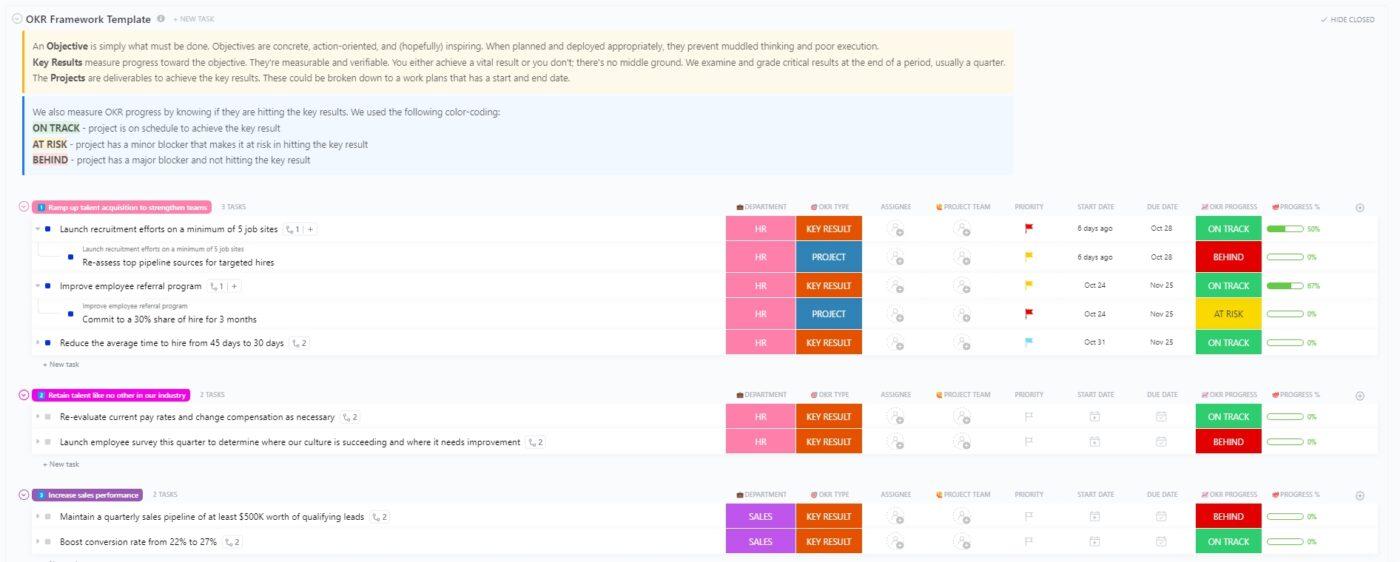
To implement a complex system such as continuous performance management, you must plan each element perfectly. You must divide the process into manageable tasks and determine who best fits each role. It’s also important to set a realistic but cost-effective timeline for accountability’s sake. 📆
You can leverage ClickUp’s wide range of project management features and customization options to plan the transition. The platform’s hierarchical structure allows you to organize all the documentation and work so everything’s easily accessible. You can also alter permissions to ensure data confidentiality.
Create tasks and subtasks, assign them, and schedule them in a few clicks. With ClickUp’s Workload view, you can assess the capacity and availability of each participant. The ClickUp Gantt view allows you to visualize the timeline of your implementation process as well as the dependencies between tasks.
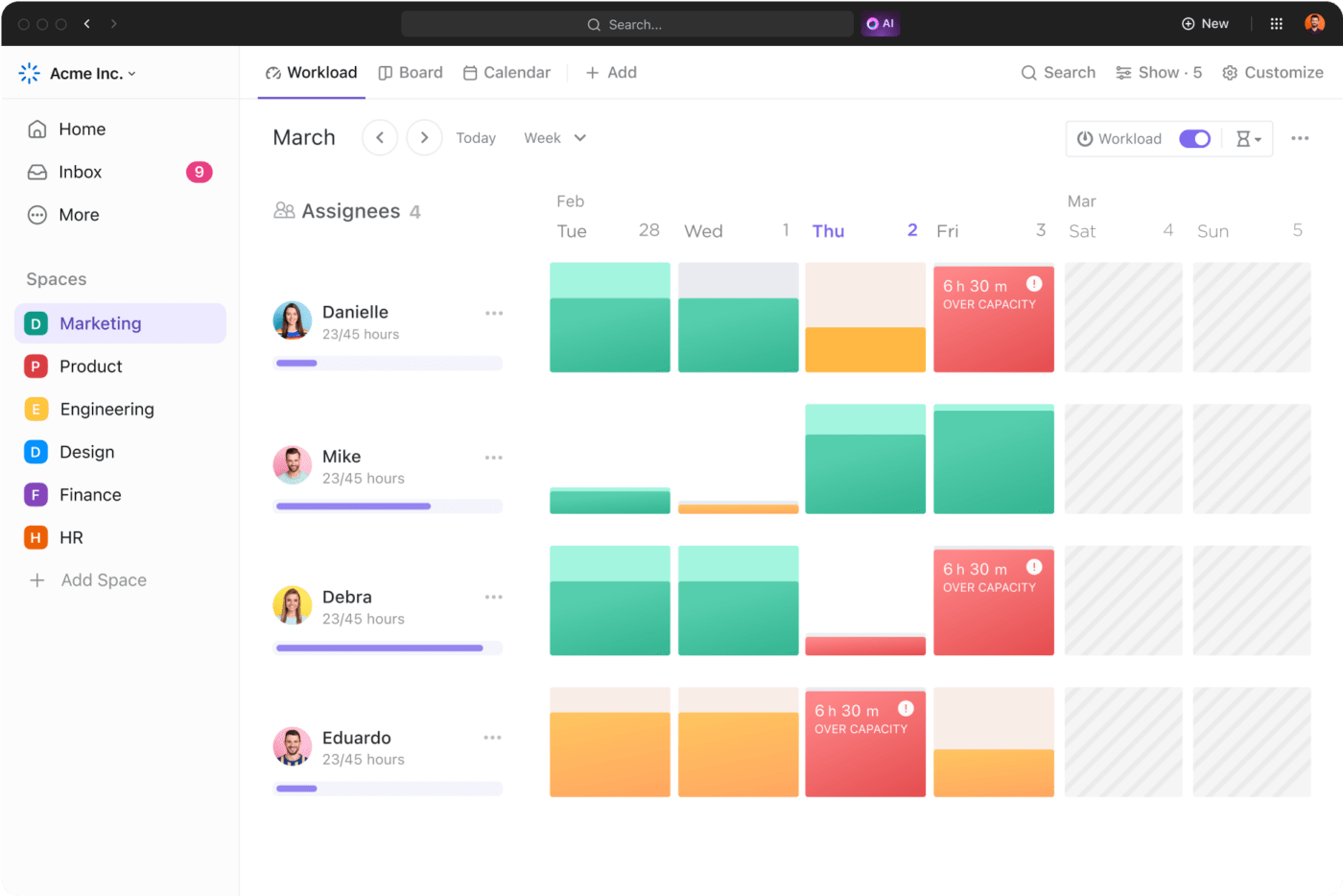
Within each Task view, you can add anything the assignee may find useful when working on the task, such as:
ClickUp streamlines your workflow and simplifies collaborative work management across teams, reducing the need for unnecessary emails and meetings.
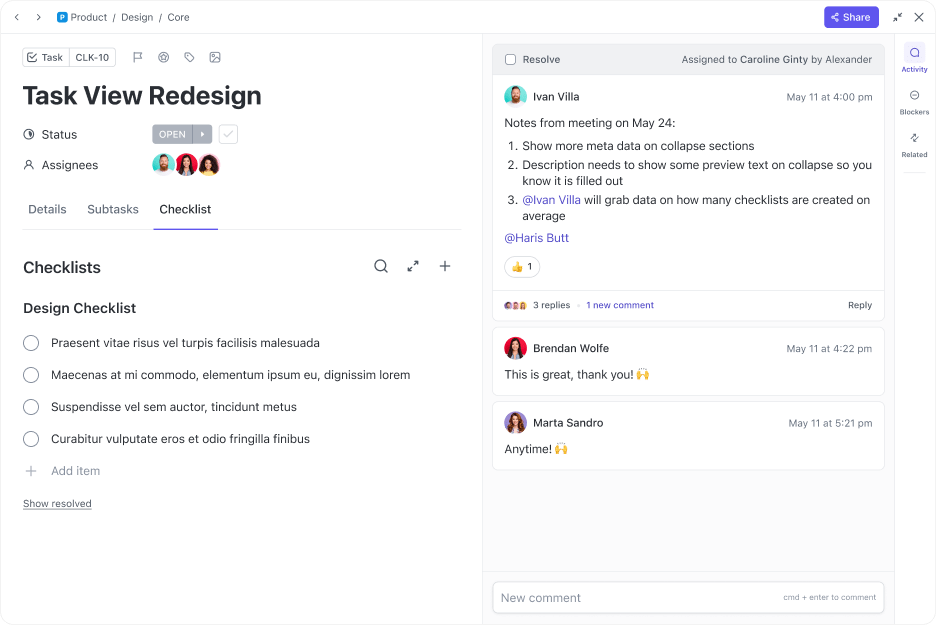
Documentation is a key element to executing any project, let alone a complicated one such as continuous performance management. Once you’ve agreed on all the details with stakeholders, record all the information. That way, if anyone has any questions or needs to refresh their knowledge about the performance management process, they can revisit the documentation at any time. 📃
For example, you can create a standard operating procedure (SOP) document outlining the most important points that managers need to cover when conducting check-ins. You can also include company-wide evaluation standards and provide instructions on how to write and format performance review documents.
You can do all that with ClickUp Docs, the platform’s rich text editor. Link tasks, add cards, and embed bookmarks in your docs. Manage permissions and invite stakeholders to edit or chime in with comments.

The continuous performance management strategy requires a lot of adaptation on the managers’ part. They’re also pivotal for its success, so you must devise a comprehensive training plan. Train managers on how to observe behavior, what tools to use, and how to assign performance ratings based on the preset goals.
You should also let your employees know about the upcoming change. Explain why it’s necessary and what’s in it for them.
Provide support for managers and employees before, during, and after the transition. 👐
As your managers carry out your new performance management system, monitor the goings-on so you can ensure adherence to deadlines and goals.
You can use ClickUp’s Timeline view to track performance of individual team members. If you want to get a quick overview of everyone’s performance, build a custom ClickUp Dashboard with cards and reports most relevant to you.
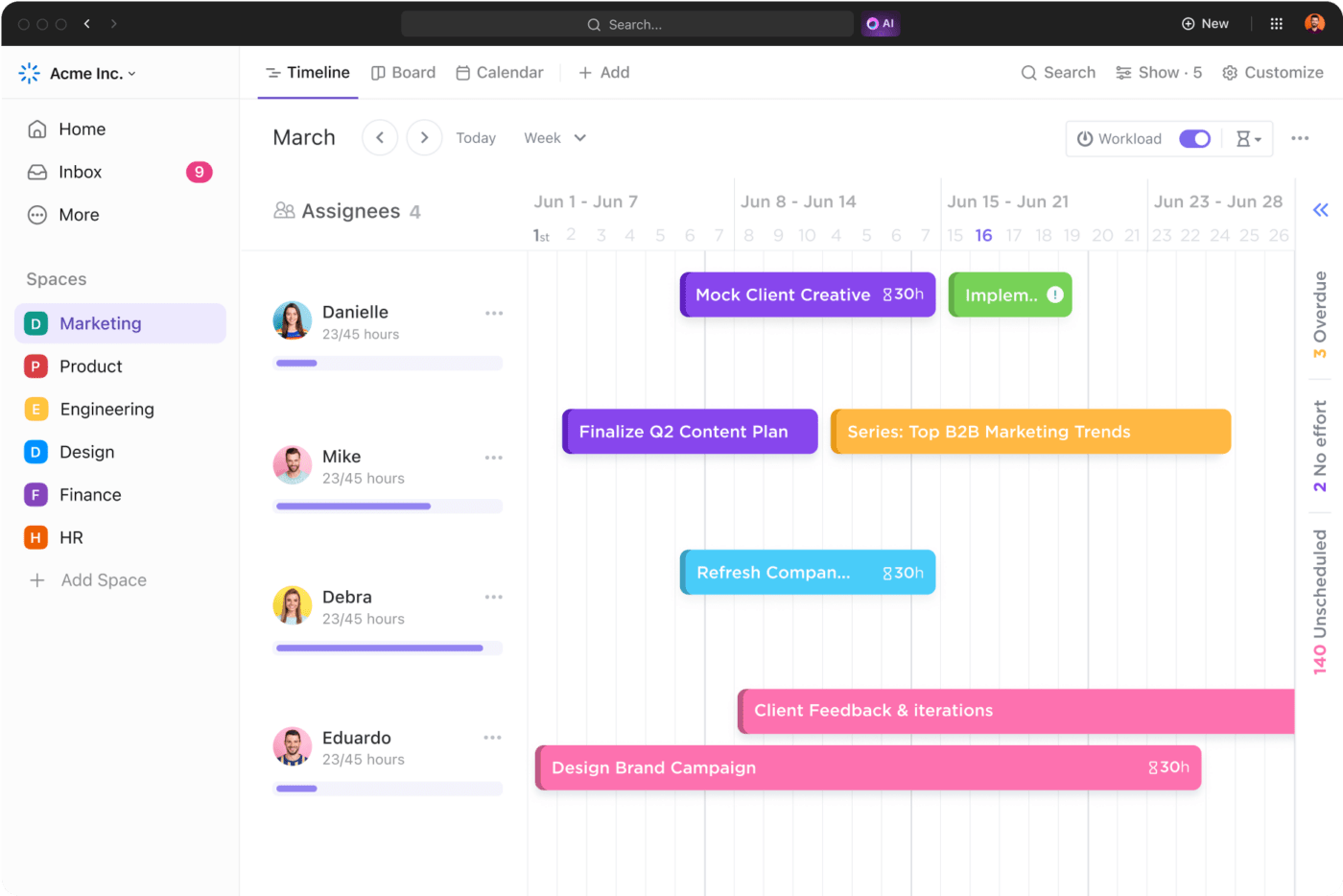
It’s also important to analyze the new process and optimize it as you go. Collect real-time feedback from managers and employees and make the necessary changes. You can use ClickUp Forms to gather input. The platform will automatically turn responses into tasks to help you bring them to fruition timely.
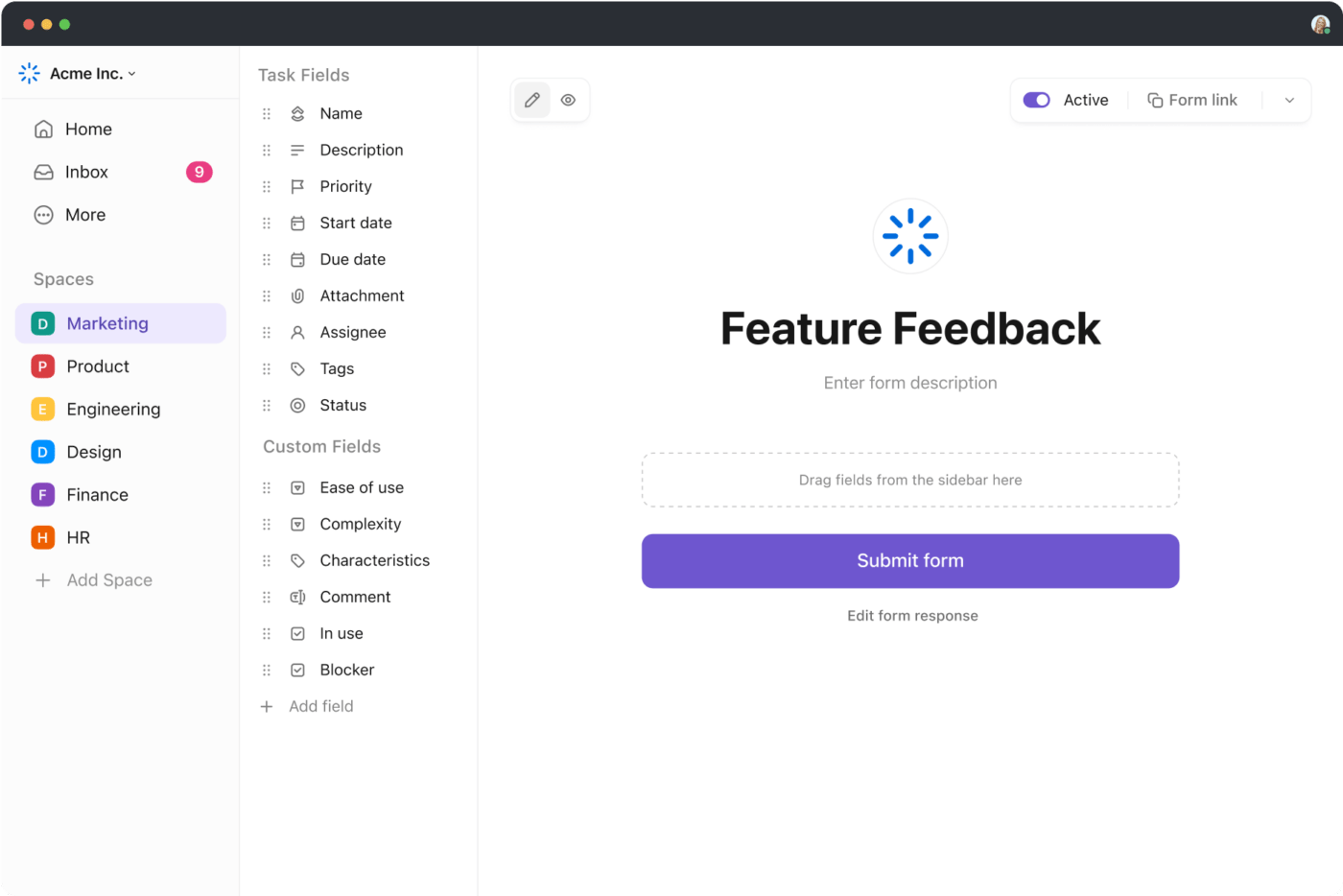
Companies can run into many roadblocks when integrating continuous performance management into their workflow. 🚧
Read about them and their typical solutions below:
Continuous performance management emerges as the less stressful and more effective alternative to yearly performance reviews. With its short-term collaborative goals, regular check-ins, and two-sided frequent feedback, it promotes ongoing professional growth and enhances employee engagement.
Adopting the system may not be a simple endeavor, but using continuous performance management software such as ClickUp can help you stay on top of all the elements and set you up for success. Sign up for ClickUp and use it to sail through any project, no matter how big or small. ⛵
© 2025 ClickUp